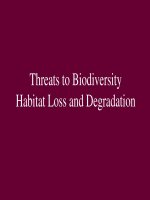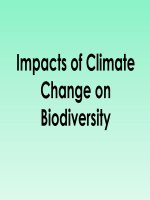Bài giảng habitat loss and degradation
Bạn đang xem bản rút gọn của tài liệu. Xem và tải ngay bản đầy đủ của tài liệu tại đây (2.78 MB, 26 trang )
Threats to Biodiversity
Habitat Loss and Degradation
Significant and largely irreversible
changes to biodiversity in the world
– The distribution of species on Earth
is becoming more homogenous
– The population size or range (or
both) of the majority of species
across a range of taxonomic groups
is declining
– Humans have increased the species
extinction rate by as much as 1,000
times over background rates typical
over the planet’s history (medium
certainty)
– 10–30% of mammal, bird, and
amphibian species are currently
threatened with extinction (medium
to high certainty)
Unprecedented change:
Ecosystems
–
–
5-10% of the area of five
biomes was converted
between 1950 and 1990
More than two thirds of the
area of two biomes and
more than half of the area
of four others had been
converted by 1990
Millenium Ecosystem Assessment
Assessment Synthesis Report
/>
Unprecedented change:
Biogeochemical Cycles
• Since 1960:
– Flows of biologically available
nitrogen in terrestrial ecosystems
doubled
– Flows of phosphorus tripled
• > 50% of all the synthetic nitrogen
fertilizer ever used has been used since
1985
• 60% of the increase in the atmospheric
concentration of CO2 since 1750 has
taken place since 1959
Human-produced Reactive Nitrogen
Humans produce as much biologically
available N as all natural pathways and this
may grow a further 65% by 2050
Human Population Growth
Source: Data from U.S. Census Bureau
World
Population
Clock
Human Footprint
Source: Sanderson et al., 2002
• Biodiversity is in decline due to a
diversity of threats (direct threats:
overexploitation, habitat loss,
pollution, etc. and indirect threats:
poverty, population growth etc.)
Threats Biodiversity
Direct
• Habitat loss and
degradation
• Overexploitation
• Invasive species
• Pollution
• Global climate
change
Underlying (indirect)
• Overpopulation
• Over-consumption
• Reduced or negative
incentives to conserve
• Lack of enforcement
Road Construction
- Roads damage habitat
- Roads cause habitat
fragmentation
- Roads increase disturbance
- Roads limit movement of
wildlife
- And more….
Source: NASA
Effects of road on exotic/native plant species
Source: Gelbard and Belnap, 2003
Dam Construction
- Blocking migratory species
- Changing turbidity
- Filtering out of woody debris
which provides habitat and
sustain a food change
-Trapping silt in reservoirs and
reducing downstream
productivity
- Changing temperature and
oxygen conditions
Source: bashny.net
- And more ….
Survival rate before and after dam construction
Source: Raymond, 1979
Deforestation
■ Forests are habitat for a
majority of the earth’s known
species.
■ Forests are being lost faster
than they are growing.
Source: nimbuseco.com
■ Forests cover less than 6% of
the earth’s total surface area.
Effects and Types of Fragmentation
• Loss of Ecosystems
and Habitats
• Decreased Patch Size
• Increased Edge
Effects
• Increased Patch
Isolation
• Changes in Species
Diversity,
Composition and
Interactions
Area: 16 sq km
Edge: 32 km
Source: Murphy©AMNH-CBC
Area: 16 sq km
Edge: 16 km
Dispersal and fragmentation
Source: Gibbs
Habitat quality: Interior vs. Edge
Edge zone:
- Windier
- Drier
- Warmer
- Higher competition between:
Native and exotic species
- More disturbance
Edge Effects
• Physical
– Microclimate changes
in light, temperature,
& wind
– Humidity 100m
• Biological
– Exotic Plants and
Insects
– Invasive Plants,
Insects and animals
– Bird Density 100m
• Synergistic
– Fire
– Hunting pressure by
humans and other
predators
Frey © AMNHCBC
Nature of Fragmentation
Natural
SOURCE: DEPARTMENT OF THE INTERIOR, A. ADAMS
Complex patch
Less distinct edge
Human Caused
SOURCE: FREY©CBC-AMNH
Distinct Edge
Simplified
Patch
Loss and Degradation of
Natural Habitat
- It is estimated that forests
(including mangroves) cover about
17.4 to 27.5 percent of the country,
but only a small subset of this area
can be considered in healthy
condition.
- Primary forest continues to
decrease drastically and presently
covers less than 10% of the
country’s land (MOSTE, 1998;
Poffenberger and Nguyen, 1998)
Kevin Frey/CBC-AMNH
Loss and Degradation of
Natural Habitat
Source: World Bank, 2005
Wetlands
• Fresh and Marine
– Drained
– Filled
– Developed
All photos Source: National Oceanic & Atmostpheric Administration
Commerce Department
Changes in mangrove forest area
Source: World Bank, 2005
Causes
• Agriculture
• Resource
Extraction
• Human
Settlement
• Industrial
Development
Source: Frey©AMNH-CBC
Causes of Deforestation
- Uncontrolled logging
- Agricultural expansion
Don Pirot
- Road construction
Ned Horning
Causes of Deforestation
- Fire wood collection
- Ultimately, pressures from
high population growth
Craig Lieb









